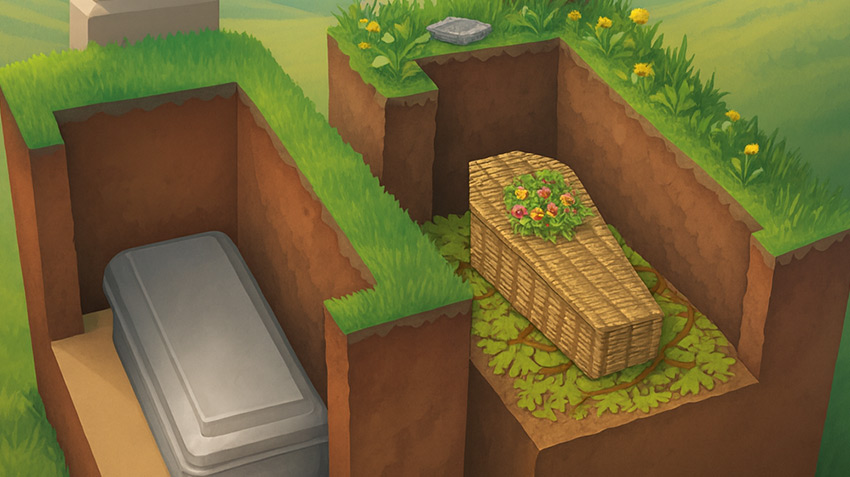
In recent years, there has been growing interest in eco-conscious end-of-life options that prioritize environmental sustainability and simplicity.
One such option gaining attention is the natural burial, also called green burial. Our insights aim to educate families, individuals planning ahead, and those seeking alternatives to traditional burial methods about what a green burial entails, how it works, and why it might be the right choice for them.
1. What is a natural burial?
A green burial is a method of burial designed to allow the body to return to the earth naturally, minimizing environmental impact. Unlike traditional burials that often involve embalming chemicals, metal caskets, and concrete vaults, green burials emphasize simplicity and ecological responsibility. Bodies are laid to rest without embalming fluids, in biodegradable caskets or shrouds made of natural materials such as untreated wood, wicker, or natural fiber fabrics. The goal is to promote natural decomposition and encourage the body to reintegrate with the soil.
This approach aligns with principles of sustainability, aiming to reduce the carbon footprint associated with funerals and promote the health of the Earth. Green burial grounds often resemble conservation areas more than traditional cemeteries, with fewer manicured lawns and more native vegetation.
2. How does a natural burial work?
The process begins at death, similar to other burial methods, but differs significantly in preparation and final resting practices. Typically, the body is not embalmed, as embalming fluids contain chemicals that can harm the environment. Instead, the body is prepared using more natural preservation methods if needed.
These types of burials can take place in dedicated green burial grounds, which are cemeteries designed specifically to accommodate these practices. Some hybrid cemeteries offer both traditional and green burial options, while in some states, private land may be used for green burials under specific regulations.
Materials used in green burials are biodegradable and often sourced sustainably. Natural fiber shrouds, untreated wooden caskets, wicker baskets, or even cardboard coffins are common choices. These materials break down over time, enriching the soil rather than persisting as waste.
Legal considerations vary across the United States. While green burials are generally permitted, specific state laws govern cemetery operations, burial depths, and the use of certain materials. Families should consult local regulations and work with funeral directors familiar with green burial practices to ensure compliance.
3. Why do people choose natural burial?
There are several compelling reasons why green burial is becoming a preferred choice for many. Environmental concerns top the list, as traditional burial practices often involve harmful chemicals, non-biodegradable materials, and energy-intensive maintenance such as mowing and irrigation. These burials significantly reduce the carbon footprint of the burial process and avoid introducing toxins into the soil.
Beyond environmental factors, many individuals are drawn to green burial because of personal or spiritual beliefs. The desire to reconnect with nature and embrace simplicity at the end of life resonates with many faith traditions and philosophies that honour the earth.
Cost is another important consideration. Green burials generally cost less than traditional ones since they avoid embalming, expensive caskets, and vaults. This makes green burial an accessible option for those mindful of funeral expenses without compromising dignity and respect.
4. How is a green burial different from a traditional burial?
The differences between green burial and traditional burial methods are distinct and significant. Traditional burials typically involve embalming to preserve the body for viewing, which uses chemicals like formaldehyde. These chemicals pose environmental risks by contaminating soil and groundwater. Green burials omit embalming, allowing the body to decompose naturally.
In traditional burials, metal or hardwood caskets are often encased in concrete vaults. These vaults prevent the earth from settling but also interfere with natural decomposition and require substantial energy and material resources to manufacture. Green burials use biodegradable containers or shrouds, supporting the earth’s natural cycles.
Visually and environmentally, green burial grounds look different from conventional cemeteries. They often incorporate native plants, wildflowers, and trees, creating habitats for wildlife. This design promotes ecological restoration and conserves green space.
5. Are green burials legal in the United States?
Green burial is legal throughout the United States, but regulations differ from state to state and by cemetery. Some states have more permissive laws allowing burials on private land or less restrictive requirements on burial depth and materials. Others require burials to occur only in licensed cemeteries, which may or may not accommodate green burial.
Many cemeteries across the country now offer green burial options, often certified or recognized by organizations like the Green Burial Council. Funeral directors play a critical role in guiding families through legal requirements and facilitating the burial process. While they are typically involved, some states allow families to manage green burials with fewer formalities.
6. Where can you have a green burial in the US?
Green burial grounds, also known as green cemeteries or conservation cemeteries, are increasingly available throughout the US. These cemeteries focus on preserving natural landscapes and offer burial options that meet ecological standards.
Finding a green burial site near you can be done through resources like the Green Burial Council, which maintains a directory of certified green burial grounds. Other organizations and local funeral homes can also provide information about available options in your region.
When considering green burial as part of retirement and estate planning, it is important to research nearby cemeteries and understand their policies to ensure your wishes can be fulfilled.
Frequently Asked Questions
Below are some commonly asked questions to consider:
What happens to the body during natural decomposition in a green burial?
In green burial, the body decomposes through microbial and insect activity, gradually returning to the soil without the interference of chemicals or synthetic materials.
Can ashes be buried naturally if cremation is chosen instead?
Yes, ashes can be buried in biodegradable urns in green burial grounds, though cremation itself is a separate process from green burial.
Are there any religious restrictions on green burial?
Many religions support green burial practices due to their simplicity and respect for nature, but it is advisable to consult religious leaders for specific guidance.
Natural burial: Honoring life with an eco-friendly farewell
Natural burial represents a meaningful and environmentally responsible alternative to traditional burial practices. It honors the cycle of life and death by allowing the body to return to the earth without harmful chemicals or non-biodegradable materials. With growing interest in sustainable living and end-of-life choices, green burial offers a way for individuals and families to align their values with their final wishes.
For those considering green burial as part of retirement and estate planning, this method not only reduces environmental impact but also often offers a more affordable option while maintaining respect and dignity. As legal acceptance grows and more green burial grounds become available, this option is becoming accessible to many seeking a simpler, greener way to say goodbye.
Speak to a professional funeral services provider to learn more about eco-friendly burial options.



